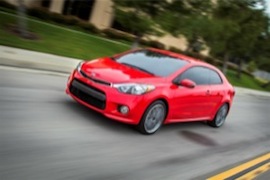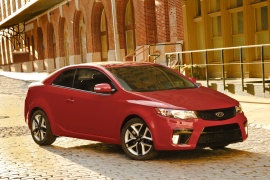KIA Forte Koup Models/Series Timeline, Specifications & Photos
First production year: 2009
Engines: Gasoline
Body style: Coupé (two-door)
Just four years after the launch of the two-door version of the Forte, also known as the Cerato on other markets, the Korean automaker introduced the second generation of this moniker with improved everything, from styling to drivetrains.
Kia wasn’t known as a significant player in the sport compact segment, a territory where the Honda Civic Si and other similar vehicles made the rules. Still, the Korean automaker tried to get involved and deliver a sports-oriented but budget-priced vehicle. Furthermore, besides the price, the car came well-equipped and even had some amenities available only on expensive vehicles. Kia also offered an incredible ten-year or 160,000 km (100,000 miles) warranty for the Forte Koup, depending on the market. Unfortunately, there was not enough market for it, and in 2016, the automaker pulled the plug on it due to slow sales.
The second generation of the Forte Koup featured swept-back headlights, LED positioning lights, and fog lamps, with an option for HID main beams. Between them, the automaker placed a narrow grille that followed the “Tiger Nose” design language imagined by Peter Schreyer. On the lower side of the bumper, the automaker put a broad, trapezoidal-shaped air intake flanked by a pair of scoops that housed the fog lamps. It is worth noting that these amenities were available for both vehicle grades, the EX and the SX.
From its profile, the ascending waistline of the car revealed a muscular-looking greenhouse with narrow windows on the sides and raked-forward C-posts. The flared wheel arches and the very short deck further emphasized the sporty coupe from Kia. Those looking for the base trim level received it with 16-inch alloy wheels, while the upper grade fitted as standard with an 18-inch set. At the back, the automaker placed wide LED taillights extended from the rear quarter panels onto the trunk’s lid. Finally, on the lower bumper, the automaker placed a broad valance that mimicked the look of the front one and flanked it with a pair of chromed-tipped exhausts.
Inside, customers were greeted by a modern-looking dashboard. The binocular-styled instrument cluster of the previous generation was replaced by a fresh-looking one featuring large dials for the speedometer and tachometer that flanked a TFT display showing data from the car’s onboard computer. The SX version came with keyless entry and start. Atop the center stack, the automaker placed a touchscreen for the infotainment system that controlled the audio, and underneath it, the HVAC controls. Several carbon fiber-looking textures decorated the dashboard and the seats. Those who opted for the higher grade received a heated and cooled driver seat and a heated passenger seat. In the back, headroom was limited due to the low-profiled roofline.
Under the hood, Kia installed a choice of two engines and transmissions. The base model came equipped with a two-liter naturally aspirated inline-four, while the SX was powered by a turbocharged 1.6-liter gasoline unit featuring direct fuel injection. They could be paired with a six-speed manual or a six-speed automatic that sent power to the front wheels.
Kia introduced its first-ever sporty coupe in 2009 at the New York International Auto Show, trying to lure customers from Honda and Scion alike, but the timing was far from perfect.
While other automakers tried to dodge the bankruptcy bullet, Kia expanded the Forte range in an unusual segment for the Korean brand: the sport-compact coupe. The car manufacturer took the platform from a four-door Forte, decreased the overhangs, and kept just one body panel: the clamshell hood. The interior, on the other hand, while still carrying over several parts from its family-oriented sibling, was designed and equipped for the younger generation. Soon, customers learned that the Forte Koup was more than just a pretty face on the market since it was available with sporty drivetrains.
At the front, the angular-shaped headlights were narrower on their inner side than on the outer ones, resembling those from the same-era Honda Civic Si. Between them, the automaker installed a honeycomb pattern for the grille where the Kia badge took center stage. On the lower part of the bumper, the automaker installed a broad center air intake flanked by squared-shaped side scoops that housed the available fog lamps.
From its profile, the ascending waistline of the vehicle created a sporty image of the car. Depending on the grade, the car rolled on 16- or 17-inch alloy wheels, which made it look even more competitive. The front doors were long since they had to provide access for the rear passengers. The car had just two trim levels: the EX and the SX. The former was more of a budget-friendly coupe, while the latter was more focused on performance, hence the standard bigger wheels. At the back, the corner-mounted taillights echoed the shape of the headlights and were stretched from the quarter panels to the trunk lid. Lower, on the bumper, the automaker installed a black valance for the SX version and integrated a twin exhaust with chromed tips to emphasize the car’s sporty character.
Inside, the dashboard was still made with hard plastic areas. It was borrowed from the four-door Forte. Fronting the driver was a three-dial instrument panel with a binocular styling. The speedometer was in the middle and flanked by the tachometer on the left and by the fuel and temperature gauges on the right. On the center console, the automaker placed a six-speaker sound system for the base model. At the same time, the upper grade received an improved one with LEDs surrounding the front speakers. Kia also installed a pair of bolstered seats for the front occupants and a 60/40 split-folding bench seat in the back. The legroom there was adequate for two, but the headroom was not on the highest standards.
Under the hood, the automaker installed two gasoline engines: a 1.6-liter and a 2.4-liter. Both were naturally aspirated. The former was paired with either a five-speed manual or a four-speed automatic, while the latter came with a six-speed manual and five-speed automatic. Both versions sent their power to the front wheels.

